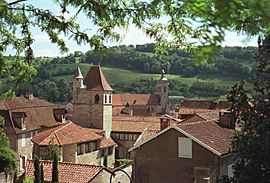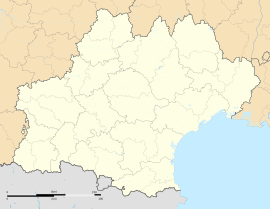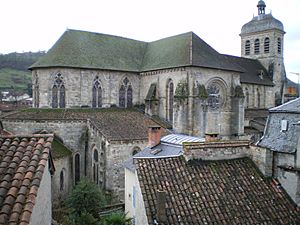Figeac facts for kids
Quick facts for kids
Figeac
|
||
|---|---|---|
|
Subprefecture and commune
|
||

A general view of Figeac
|
||
|
||
| Country | France | |
| Region | Occitanie | |
| Department | Lot | |
| Arrondissement | Figeac | |
| Canton | Figeac-1 and 2 | |
| Intercommunality | Grand-Figeac | |
| Area
1
|
35.16 km2 (13.58 sq mi) | |
| Population
(2021)
|
9,770 | |
| • Density | 277.87/km2 (719.7/sq mi) | |
| Time zone | UTC+01:00 (CET) | |
| • Summer (DST) | UTC+02:00 (CEST) | |
| INSEE/Postal code |
46102 /46100
|
|
| Elevation | 170–451 m (558–1,480 ft) (avg. 225 m or 738 ft) |
|
| 1 French Land Register data, which excludes lakes, ponds, glaciers > 1 km2 (0.386 sq mi or 247 acres) and river estuaries. | ||
Figeac is a lovely town in southwestern France. It is located in the Lot department. Figeac is also a sub-prefecture, which means it's an important administrative center for the area.
Contents
Exploring Figeac's Location
Figeac is on the via Podiensis. This is a famous old path that pilgrims used to walk. It is part of the larger Camino de Santiago network. Today, this path is known as the GR 65 in France. It is a popular route for long-distance hikers.
Figeac also has a busy train station. You can catch trains from here to other cities. These include Brive-la-Gaillarde, Toulouse, Aurillac, and Rodez.
Figeac's Rich History and Culture
Figeac is known as a "city of art and history." This means it has many important historical buildings and cultural sites. The Midi-Pyrénées Regional Council has even called it one of the "Great Sites of Occitania."
The old part of Figeac still looks much like it did in the Middle Ages. It has winding streets and many old houses. These houses are often made of sandstone.
Important Buildings and Monuments
Churches and Religious Sites
Figeac has several beautiful old churches. They are very important to the town's history.
- Chapel Notre-Dame-de-Pitié de Figeac: This chapel was built in the 13th century. It is part of the Église Saint-Sauveur. It became a historical monument in 1840.
- Chapelle de l'hôpital de Figeac: This is another chapel located at the hospital.
- Église Saint-Dau de Ceint-d'Eau: This church is also a part of Figeac's religious heritage.
The Saint-Sauveur Church
The Saint-Sauveur Church is a very old building. It was named a historical monument in 1840. Many old religious items are kept here. This church is the only part left of an old Cluny abbey. It was officially opened in 1092. Saint Hugh was its abbot.
The church has been changed over hundreds of years. This happened because of wars, like the Hundred Years' War. It also changed during the French Wars of Religion. But it is still standing today.
It was a church where people would go on a pilgrimage. It was as big as other famous pilgrimage churches. It has three main sections, a large transept, and chapels. The old meeting room has beautiful wooden decorations from the 17th century.
An old capital from this church is now in New York. A capital is the top part of a column. This one was made into a font. You can see it at The Cloisters museum.
The Carmes Church
This church was listed as a historical monument in 1993. It used to be called the Church of Saint-Thomas-Becket. It is the smallest church in Figeac. It is near the hospital. This church is the last part of an old Carmelites convent.
The Notre-Dame-du-Puy Church
This church was named a historical monument in 1916. It sits on a hill and looks over all of Figeac. It started as a Romanesque church. This means it was built in a style common in Europe around the 11th and 12th centuries. It was changed many times, especially in the 14th and 17th centuries.
The choir area has lovely carved Romanesque capitals. It also has a large carved walnut altarpiece from 1696. This is the oldest church in Figeac. A local story says that the Virgin Mary made a hawthorn tree bloom here in winter. This church was also a meeting place for a group of people who followed Saint James.
Museums in Figeac
The Champollion Museum
The city is home to the Champollion Museum. Its full name is "the writings of the world." More than 40,000 people visit it every year. At the museum, you can learn how writing first appeared in the world. This history goes back 5,000 years!
The Champollion Museum is the main museum in Figeac. But there are other museums too. These include the Musée Paulin-Ratier, the Musée de la Résistance, and the Musée d'histoire de Figeac. The history museum was updated in 2012. It is set up like old "cabinets of curiosities." It is in rooms that used to be part of a seminary, behind the Notre-Dame-du-Puy church.
The Place des Écritures
This square is in the middle of old medieval buildings. Its ground is covered with a huge copy of the Rosetta Stone. It is 14 meters long and 7 meters wide. It is carved from black granite from Zimbabwe. An American artist named Joseph Kosuth created it. It was opened in April 1991. You can also see this amazing artwork from the museum's garden. In a nearby courtyard, the French translation of the Rosetta Stone is carved on a glass plate.
The Champollion Obelisk
An obelisk is a tall, thin, four-sided stone pillar. On March 11, 1832, the town council decided to build one. It was to honor Champollion. People donated money, raising 4,000 francs. Two years later, a granite pillar 7.8 meters tall was taken from a rock in Golinhac. It has hieroglyphs carved on it that mean "Forever!" It also has two bronze plaques with Egyptian carvings at its base.
Place Carnot
This square used to be called the Place de la Halle. It is surrounded by impressive houses. Some are made of cob, a natural building material. Many have balconies made of wrought iron. Under the roofs, you can see open covered galleries called soleilhos. These were once used to dry clothes or animal skins. They were also a cool place to relax on a hot summer evening.
The Needles of Figeac
Around Figeac, there are two tall stone structures called "needles." They are large, eight-sided obelisks. Each one stands on a base with four steps. They are made of strong, cemented stone. The Aiguille du Cingle is south of the city and is 14.50 meters tall. The L'aiguille de Lissac, or Nayrac, is to the west and is 10.50 meters tall.
Famous People from Figeac
Jean-François Champollion was born in Figeac. He was the first person to translate Egyptian hieroglyphs. His father had a bookshop in the village. The Champollion Museum is in Figeac. On the Place des écritures (writings square), there is a giant copy of the Rosetta stone. This was made by Joseph Kosuth.
Other famous people from Figeac include:
- Théodore Ber: A French explorer and archeologist. He spent most of his life in Peru.
- Lotte H. Eisner: A German film historian. She hid in Figeac during World War II.
- Charles Boyer: A famous actor.
- Vincent Beduer: A football player.
Figeac's Economy
The city is home to the main office of Figeac Aero. This is a company that works in the aerospace industry.
Figeac in Movies
The 1974 film Lacombe Lucien, directed by Louis Malle, was filmed in Figeac.
See also
 In Spanish: Figeac para niños
In Spanish: Figeac para niños









